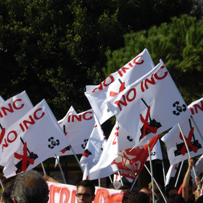Territorial Conflicts: Six Interpretations
Abstract
In contemporary societies, territorial conflicts, i.e. conflicts concerning unwelcome facilities or LULU (Locally Unwanted Land Use), tend to be more frequent and widespread than social conflicts. These conflicts are characterized by the protest of local communities that fight for the defence of their land from external aggressions, such as invasive artefacts (motorways, high speed lines, waste disposal plants, etc.) or human settlements (Roma camps, mosques, immigrants, etc.).
This article aims to answer to three questions: 1) why these conflicts have increased in last decades? 2) what is their real stake? 3) how can be dealt with and with which possible outcomes?
There is no single answer to these questions. If we take into consideration the discourses that are made on this issue, six types of narratives emerge that go in different directions. The territorial conflicts are seen, from time to time. (a) as the expression of particularistic and egoistic points of view that prevent the fulfilment of the general interest, (b) as the pressure of vested interests that exploit to the fear of the population for other purposes; (c ) as the consequence of the imbalance between concentrated costs and distributed benefits; (d) as a reaction to risks that are deemed unacceptable; (e) as the resistance of the places against the flows that invade or cross them; (f) as a demand for a different model of development.
The conclusion is that such conflicts are multi-faceted phenomena. If we pay attention - as the current debate often do - only on one of these several dimensions, we risk to content ourselves with a simplified and, thereby, distorted interpretation.
Downloads
References
Beck U. (2000) La società del rischio. Verso una seconda modernità, Roma, Carocci.
Bobbio L. (1999) “Un processo equo per una localizzazione equa”, in L. Bobbio e A. Zeppetella (a cura di), Perché proprio qui? Grandi opere e opposizioni locali, Milano, Franco Angeli, pp. 185-237.
Bobbio L. (2002) “Come smaltire i rifiuti. Un esperimento di democrazia deliberativa”, Stato e Mercato, n. 64, aprile 2002, pp.101-141.
Bobbio, L. (2010) “Il dibattito pubblico sulle grandi opere. Il caso dell’autostrada di Genova”, Rivista italiana di politiche pubbliche, n. 1, pp. 119-146.
Bobbio L., Zeppetella A. (a cura di) (1999) Perché proprio qui? Grandi opere e opposizioni locali, Milano, Franco Angeli, pp. 185-237.
Caruso L. (2010) Il territorio della politica. La nuova partecipazione di massa nei movi-menti No Tav e No Dal Molin, Milano, Franco Angeli.
Castells M. (2002) L’età dell'informazione : economia, società, cultura, Milano, EGEA Università Bocconi.
della Porta D., Piazza G. (2008) Le ragioni del no. Le campagne di protesta contro la TAV in Val di Susa e il ponte sullo Stretto, Milano, Feltrinelli.
Dente B. (2011) Le decisioni di policy, Bologna, Il Mulino.
Fedi A., Mannarini T. (a cura di) (2008) Oltre il Nimby. La dimensione psico-sociale della protesta contro le opere sgradite, Milano, Framco Angeli.
Fisher R., Ury W., Patton B. (2007), L’arte del negoziato, Milano, Corbaccio.
Ferrero P. (2008) “Non passa lo straniero”, L’Indice, 25, 5.
Lolive J. (1999) Les contestations du TGV méditerranée : projet, controverse et espace public, Paris, L'Harmattan.
Mansillon Y. (2006) “L’esperienza del ‘débat public’ in Francia”, Democrazia e diritto, n. 3, 2006, pp. 101-114.
Occhilupo R., Palumbo G., Sestito P. (2011) “Le scelte localizzative delle opere pubbliche: il fenomeno Nimby”, in Banca d’Italia, Le infrastrutture in Italia: dotazione, pro-grammazione, realizzazione, Rome, Banca d’Italia, pp. 319-356.
Revel M., Blatrix C., Blondiaux, L., Fourniau J.M., Dubreuil B. H., Lefebvre R. (a cura di) (2007) Le débat public : une expérience française de démocratie participative, Paris, La Découverte.
Pellizzioni L. (a cura di)(2005) La deliberazione pubblica, Roma, Meltemi.
Pellizzoni L. (a cura di) (2011), Conflitti ambientali, Bologna, Il Mulino.
Roccato M., Rovere A., Bo G. (2008) “Interessi particolari e interessi generali”, in Fedi, A. e Mannarini, T. (a cura di), Oltre il Nimby. La dimensione psico-sociale della pro-testa contro le opere sgradite, Milano, Franco Angeli, pp. 43-66.
Shrader-Frechette K. S. (1991) Risk and Rationality, Berkeley, University of California Press.
Susskind L. e Cruikshank J. (1987) Breaking the Impasse. Consensual Approaches to Re-solving Public Disputes, New York, Basic Books.
Susskind L., McKearnan S., Larmer J. (a cura di) (1999) The Consensus Building Hand-book. A Comprehensive Guide to Reaching Agreeement, Thousand Oakes-London, Sage.

Copyright (c) 2014 Tema. Journal of Land Use, Mobility and Environment

This work is licensed under a Creative Commons Attribution 4.0 International License.
Authors who publish in this journal agree to the following:
1. Authors retain the rights to their work and give in to the journal the right of first publication of the work simultaneously licensed under a Creative Commons License - Attribution that allows others to share the work indicating the authorship and the initial publication in this journal.
2. Authors can adhere to other agreements of non-exclusive license for the distribution of the published version of the work (ex. To deposit it in an institutional repository or to publish it in a monography), provided to indicate that the document was first published in this journal.
3. Authors can distribute their work online (ex. In institutional repositories or in their website) prior to and during the submission process, as it can lead to productive exchanges and it can increase the quotations of the published work (See The Effect of Open Access)
